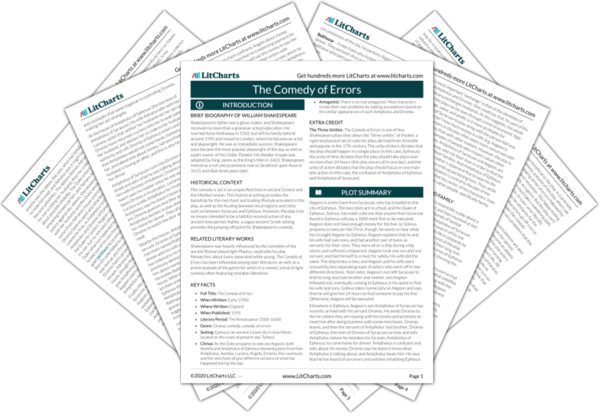Welcome to the LitCharts study guide on William Shakespeare's The Comedy of Errors. Created by the original team behind SparkNotes, LitCharts are the world's best literature guides.
The Comedy of Errors: Introduction
The Comedy of Errors: Plot Summary
The Comedy of Errors: Detailed Summary & Analysis
The Comedy of Errors: Themes
The Comedy of Errors: Quotes
The Comedy of Errors: Characters
The Comedy of Errors: Symbols
The Comedy of Errors: Literary Devices
The Comedy of Errors: Theme Wheel
Brief Biography of William Shakespeare

Historical Context of The Comedy of Errors
Other Books Related to The Comedy of Errors
- Full Title: The Comedy of Errors
- When Written: Early 1590s
- Where Written: England
- When Published: 1595
- Literary Period: The Renaissance (1500-1660)
- Genre: Drama, comedy, comedy of errors
- Setting: Ephesus (an ancient Greek city in Asia Minor, located on the coast of present-day Turkey)
- Climax: As the Duke prepares to execute Aegeon, both Aemilia and Antipholus of Ephesus demand justice from him. Antipholus, Aemilia, Luciana, Angelo, Dromio, the courtesan, and the merchant all give different versions of what has happened during the day.
- Antagonist: There is no real antagonist. Most characters create their own problems by making assumptions based on the similar appearances of each Antipholus and Dromio.
Extra Credit for The Comedy of Errors
The Three Unities. The Comedy of Errors is one of few Shakespeare plays that obeys the “three unities” of theater, a rigid neoclassical set of rules for plays derived from Aristotle and popular in the 17th century. The unity of place dictates that the play should happen in a single place (in this case, Ephesus); the unity of time dictates that the play should take place over no more than 24 hours (this play occurs all in one day); and the unity of action dictates that the play should focus on one main plot action (in this case, the confusion of Antipholus of Ephesus and Antipholus of Syracuse).





